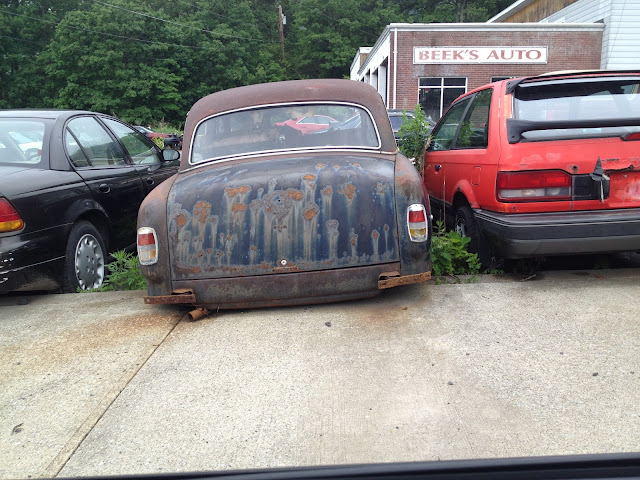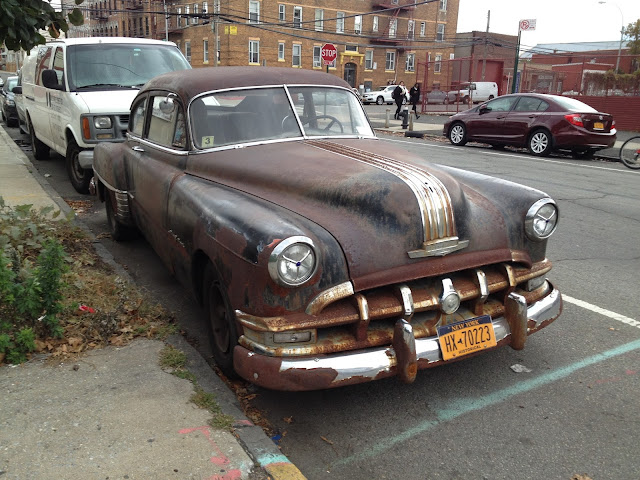FIVE OF A KIND
The dog days of summer have me relaxing as opposed to posting so I figured I'd drop a whole handful of rides that are close siblings. Without further ado;
What we have here is a 1967 Chevrolet Caprice in what might be Madeira Maroon Poly. While this is a sweet classic now it was one of the most popular cars of its day when built. Over 124,000 left the assembly line in this year alone!
Here she is parked on busy Bedford in Williamsburg. The forward-leaning style of the front end was a one year only design. The year previous didn't have those running lights on the outer edge of the grill (the turn signals are actually located down in the bumper), and the top of the grill was lower than the tops of the headlights in the following year.
The venerable 327 V8 powers this beast but it could have just as easily been a 283, 350, 396, or 427 (a mere 50 of the 427 equipped Caprices were built though so if you see one rotting away somewhere let me know!). Transmission options were also many, with 3 and 4 speed manuals and 2 different automatics all available.
This was the first year for the Caprice as a stand alone model and it represented the top of the heap for the full-size lineup.
I love the old dealership emblems they used to produce for cars. A decal is usually present now (or the phoning-it-in license plate frame) but the ones where they gave some effort to ape the chrome script of the factory emblems really stand out now. As is often the case this one has a couple of screws going directly through it to hold it in place.
Fit and finish is slightly wonky and scrapes and scuffs abound, but this is a solid and really good looking driver. If it were a show car you probably wouldn't want to park it on a busy street.
Look at all that trunk hanging out past the rear axle! In the '70s the trunk would shrink and the hood would grow to enormous lengths. This car is pretty huge by todays standards but it is somewhat balanced in its proportions.
Well we'll leave this eager punk where it sits looking ready to pounce. Now on to a more sedate, later example:
Ahhh yes, here is the serene 1973 Chevy Impala in yawn-inducing BEIGE. This color looks so gentle that it looks like it came from a hospital. If your psychologist is suddenly unavailable they could let you sit on the big bench seat inside this ride and you would feel calm.
*By the way, the only way I know of discerning an Impala from a Caprice in '73 is the grill. The Impala has twice as many horizontal and vertical lines in it as the Caprice.
*By the way, the only way I know of discerning an Impala from a Caprice in '73 is the grill. The Impala has twice as many horizontal and vertical lines in it as the Caprice.
This is pretty darn close to immaculate which is shocking for two reasons; first of all it's a 42 year old car in New York with no rust! Second of all this was the car of choice for lowriders everywhere. So many of these got used up with 100 spoke Dayton wheels, upholstered steering wheels, and hydraulics that encountering a stock version is almost impossible.
There's some faint rust at the lower edge of the concave rear window but that seems to be the extent of the damage. The trunk lid has what seems to be a mock hood scoop which is something I haven't seen on any other car.
The federally mandated bumpers were introduced in stages. This year is on the cusp where the huge front bumpers ready to withstand a 5mph crash are already in place. This is the last gasp for rear bumpers that incorporate the taillights before the regulations for the rear came due in '74.
The stock hubcaps are nice enough, and the lower body crease helps temper the dimensions of this beast. The 350 V8 was standard in '73 but you could also order a 400 and 454. Now lets lose the roof:
Here we have an EVIL 1972 Impala convertible in Tuxedo Black. This is the last year for an Impala drop-top as it would move to the upscale Caprice the following year.
The grill has been spray painted black (for extra toughness I suppose). Those cheeseball plastic mirrors are not original and I'm calling the owner out on it! The originals were square brushed stainless steel examples that fit a large car.
The grill has been spray painted black (for extra toughness I suppose). Those cheeseball plastic mirrors are not original and I'm calling the owner out on it! The originals were square brushed stainless steel examples that fit a large car.
You can see the lineup I was presented with on this block! We'll see those other rides in a minute.
The hubcaps on this beast are Chevy, but they come from an early-'80s Suburban.
The hubcaps on this beast are Chevy, but they come from an early-'80s Suburban.
A white roof on a convertible is a stroke of genius since it helps keep the interior cool in the sun. I had a convertible with a black top and interior once and even though it looked great the seats were 1,000 degrees no matter what.
Next we'll flip-flop color schemes:
Next we'll flip-flop color schemes:
This is a 1974 Caprice convertible in Antique White. It's very easy to date this car because it's the last year for the headlights being tucked in behind the leading edge of the fenders and the first year for the huge rear bumpers. This basic design would continue through '76 but the final two years had the a flat grill out front with the headlight pods on an angle leaning back. The overall impression of that look is a fainthearted attempt at making a square slab aerodynamic.
Here's that ridiculously huge rear bumper hanging off like a park bench. It also gives the impression of squinting or lazy rear taillights to me. Why you would need those additional little bumper guards on there is a mystery to me.
This was the first year for a Caprice convertible. The name on the hardtop was located on the sail panel behind the rear side window. For the convertible you can see the emblem located on the leading top edge of the quarter panel.
Now on to an interloper:
This was the first year for a Caprice convertible. The name on the hardtop was located on the sail panel behind the rear side window. For the convertible you can see the emblem located on the leading top edge of the quarter panel.
Now on to an interloper:
Here we have a 1975 Buick Electra 225 Limited in Arctic White with a Maroon vinyl landau roof. We can pinpoint the date because this is Buicks first year for square headlights and the following years would see the turn signals directly under the headlights instead of down in the bumper.
Buick was above Chevy, Pontiac, and Oldsmobile in the GM hierarchy but still below
Cadillac in luxury. Some of those extra touches exist here though like
the stand up hood ornament and the cornering lamps on the sides. Under the skin however this car is the same as the Impalas and Caprices from the same year (along with the Olds 98, Caddillac Coupe de Ville, and Pontiac Grandville for that matter).
The plastic bumper extensions missing here are easily the weakest link for all GM cars of the era. Most Buicks and Cadillacs need them replaced at some point. This car is a true hooptie with the trunk lock missing and dents, scrapes, and rust all over it.
Well there you have it for GM full size beasts from '66 and '72-'75. I've ridden in at least one example of each of these yachts and they all ride nicely with plenty of power and cushy comfort. Parts for them are readily available too since all were made in vast quantities. These days one can still be had at a reasonable rate and would be a breeze to maintain.
Well there you have it for GM full size beasts from '66 and '72-'75. I've ridden in at least one example of each of these yachts and they all ride nicely with plenty of power and cushy comfort. Parts for them are readily available too since all were made in vast quantities. These days one can still be had at a reasonable rate and would be a breeze to maintain.




























































